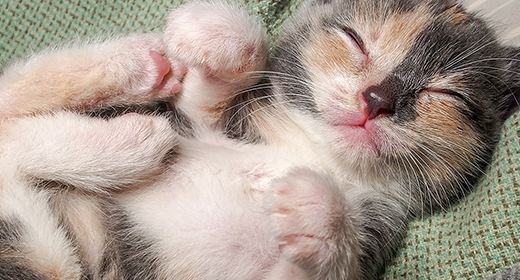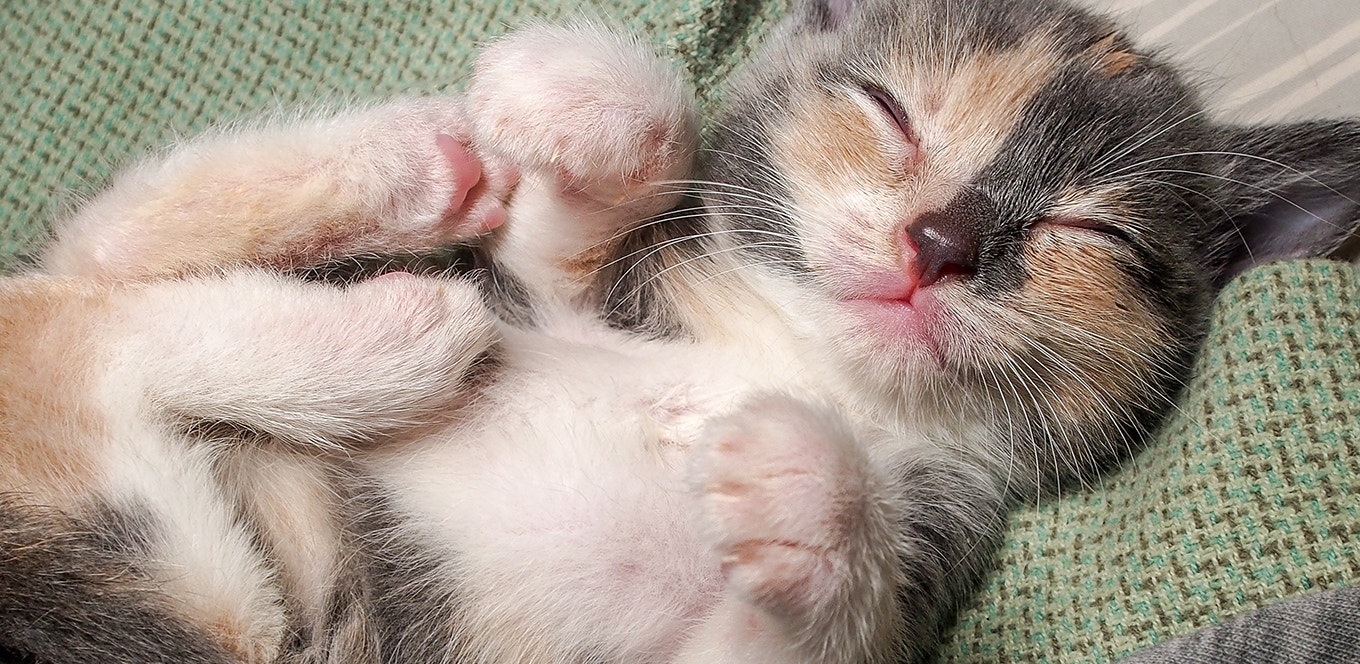

Your kitten is one of a kind, not to mention adorable. But training your li’l baby comes with some basic guidelines. Scroll on for a handful of our favorite kitten training tips.
Introduce your new kitten to their litter box as soon as they get home. Then always set your cat in their box right after meals and as soon as they wake up from naps.
And don’t forget to reward your kitten with a treat, toy or some extra love after they use it.
Kitty, meet litter.
Litter, meet kitty.
When Kitty forgets their manners and bites you or shows their aggressive side, say “ow” or “no” clearly and sternly.
Then slowly remove your hand — or other body part — from their razor-sharp clutches. Pick up your kitten, place them away from you, walk away and ignore them.
You can also redirect them to a feather wand or another toy or activity if you want. But that’s your call.
Ouch!
That’s my hand,
not a treat, tiny cat.
By giving your little feline lots of sturdy scratching posts throughout your house, especially where they like to hang out, you can save your favorite furniture from unwanted claw marks and damage.
Oh, and be sure to trim your kitten’s nails regularly.
Say it with me:
Sofas are NOT
scratching posts.
Teach your kitten that their cat carrier is a safe, comfortable place to chillax and feel protected.
Trust us, by making a carrier part of your fuzzball’s daily life, road trips and vet visits will be easier and safer for years to come.
Cozy up,
Buttercup.
It's midnight. Bring on the zoomies, furry one.
(Actually, please don’t.)
Want to stop your kitten from bouncing off the walls while you’re supposed to be deep in slumber land? Try these tips.
Have a long play session later in the evening.
Feed your feline a big meal of delicious, nutritious IAMS™ Healthy Kitten or PERFECT PORTIONS™
Spend 15 minutes of purr-worthy snuggle time before you hit the hay.
Yep, it’s true! One of our favorite studies from the University of South Australia proved it.
To help train your kitten, pick the word that best describes them:
These anxious felines tend to run away when the doorbell rings and are fearful of new situations.
The key to training a skittish kitty? Practice lots of patience and never force them to face their fears, like meeting your house guests after they’ve already runaway and hidden.
Some call them nosy, but we call them fearless. Outgoing kitties are curious and adventurous. They love to explore and get into everything — and they sometimes act naughty because they’re bored.
One of the tricks to training an outgoing kitten is to give them lots of toys and actively play with them. It stimulates their mind and helps burn off energy.
“Bossy” best describes these kitties. They bully other cats (and even other pets) and hog things like food bowls, toys and litter boxes.
If your kitten fits this category, be consistently firm and make sure you play with them regularly so they have less energy to be aggressive.
You might also want to make sure your little CEO (Cat Executive Officer) has their own food bowl, water bowl and litter box.
Two words describe these felines: impulsive and erratic. Their behavior and moods are unpredictable, even if they’ve encountered the same situation before.
When training, never raise your voice — it’ll just ramp up your kitty’s nerves and make them more erratic.
Also, be sure to stick to a consistent daily schedule for feeding and playtime so your little fuzzball knows what to expect and doesn’t get stressed out.
This personality is every cat lover’s dream.
These sweeties can usually be found curling up against your shins, meowing loudly and purring away.
The key to training these kittens is to never yell and to socialize them early and often. That way, they’ll continue to be everyone’s best friend for life.
You had me at
meow, li’l feline.





Your cat is one of a kind, so it stands to reason that you want to choose a cat food that accounts for their unique tastes, age, breed and health concerns. But with thousands of pet foods available, how do you pick the one that’s right for your cat?
First, it’s important to understand your cat’s nutritional needs. Then, you’ll need to think about your cat’s life stage, lifestyle and any health issues, and do a bit of research on cat food types, ingredients and cost. That may sound complicated, but we’ll make it easy for you — just keep reading.
Good nutrition is as important to your cat as it is to you — but their nutritional needs are quite different! Unlike humans, a cat needs a high-fat diet with less fiber. And even if you prefer a vegetarian diet, keep in mind that cats are carnivores. They need nutrients from animal protein and fat for optimal health, and they benefit from fiber for a healthy digestive tract and carbohydrates for energy.
Kittens, adult cats, nursing mothers and mature or senior cats are all examples of life stages, and each has different nutritional requirements. All cat foods should state which life stage they are recommended for — as an example, IAMS™ Proactive Health™ Mother and Kitten as well as IAMS™ Proactive Health™ Healthy Adult include the intended life stage right on the package.
Nutritional needs also vary depending on your cat’s lifestyle. A cat whose primary activity is guarding the couch doesn’t need as much energy as one who enjoys roaming outside.
.
Because cats need the nutrients found in animal sources, it’s best to pick a food in which a primary ingredient (one of the first ones listed) is an animal-based protein source such as chicken, lamb, fish, egg or one of their by-products. These ingredients contain all the essential amino acids your cat needs, including taurine, which isn’t found in a plant-based protein source. Foods that include a combination of carbohydrates in your cat’s diet, such as corn meal or barley and grain sorghum, ensure efficient absorption of nutrients and help maintain energy levels. And beet pulp is an excellent fiber source that promotes a healthy digestive tract.
For a soft, thick coat and healthy skin, your pet needs fatty acids like those found in vitamin-rich fish oils and quality fat sources such as chicken.
Cat food labels provide limited information on the nutritional value of your pet’s food because labeling regulations do not allow manufacturers to describe the quality of ingredients on the package. A reputable pet food manufacturer can explain how they evaluate and ensure the quality of their products.
When choosing cat food, the saying “You get what you pay for” definitely applies. A low price may indicate cheap ingredients or ingredients that change as manufacturer costs fluctuate. So while price is an important factor, it shouldn’t be the only one you consider.
Plus, many lower-priced products recommend higher daily portions to provide the same amount of nutrition found in a high-quality diet. To get a better idea of cost, it is the cost per feeding, not the total cost, that counts.
To figure out the cost per feeding for a cat food, divide the total cost by the number of days the product lasts. When compared closely, high-quality pet foods tend to come out on top, from both a nutritional and a cost standpoint.